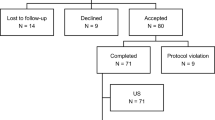Abstract
Objective
The possible adverse birth outcomes, particularly congenital abnormalities (CAs) in pregnant women with kidney stones (KS) previously have not been evaluated; therefore, we decided to study this possible association.
Methods
The population-based data set of the Hungarian Case–Control Surveillance of CAs, 1980–1996, was used for this analysis.
Results
Of 22,843 newborns or fetuses with CAs, 69 (0.30%) had mothers with KS during pregnancy. Of 38,151 matched control newborns without any abnormalities, 147 (0.39%) had KS during pregnancy. KS were associated with an adjusted prevalence odds ratio (POR) with 95% CI of 0.8, 0.6–1.0 for CAs. A higher prevalence of maternal KS during the first trimester of pregnancy was not found in any CA group. There was no higher rate of preterm birth and low birthweight in the newborns of pregnant women with KS.
Conclusions
There is no higher risk for adverse birth outcomes particularly CAs in the offspring of mothers with KS and related drug treatments during pregnancy.
Similar content being viewed by others
References
Moe OW (2006) Kidney stones: pathophysiology and medical management. Lancet 367:333–344
Pak CY (1998) Kidney stones. Lancet 351:1797–1801
Borghi L, Meschi T, Amato F, Brigant A, Novarini A, Giannini A (1996) Urinary volume, water and recurrences in idiopathic calcium nephrolithiasis: a 5 year randomized prospective study. J Urol 155:839–844
Stamatelon KK, Francis ME, Jones CA, Nyberg LM, Curhan GC (2003) Time trends in reported prevalence of kidney stones in the United States: 1976–1994. Kidney Int 63:1817–1823
Trinchieri A, Ostini F, Nespoli R, Rovera F, Zanetti G (1999) A prospective study of recurrence rate and risk factors for recurrence after a first renal stone. J Urol 162:27–30
Curhan GC, Willett WC, Knight EL, Stampfer MJ (2004) Dietary factors and risk of incident kidney stones in younger women: Nurses’ Health Study II. Arch Intern Med 164:885–891
Shepard TH, Lemire T (2004) Catalog of teratogenic agents, 11th edn. Johns Hopkins University Press, Baltimore
Czeizel AE, Rockenbauer M, Siffel CS, Varga E (2001) Description and mission evaluation of the Hungarian Case–Control Surveillance of Congenital Abnormalities, 1980–1996. Teratology 63:176–185
Czeizel AE (1997) The first 25 years of the Hungarian Congenital Abnormality Registry. Teratology 55:299–305
Czeizel AE, Intódy ZS, Modell B (1993) What proportion of congenital abnormalities can be prevented? Brit Med J 306:499–503
Czeizel AE, Petik D, Vargha P (2003) Validation studies of drug exposures in pregnant women. Pharmacoepidemiol Drug Saf 12:409–416
Soucie JM, Thun MJ, Coates RK, McClellan W, Austin H (1994) Demographic and geographic variability of kidney stones in the United States. Kidney Int 46:893–895
Heller H, Sakhaee K, Moe OW, Pak CY (2002) Etiological role of estrogen status on renal formation. J Urol 168:1923–1927
Rockenbauer M, Olsen J, Czeizel AE, Pedersen L, Sorensen HT, the EuroMAP Group (2001) Recall bias in a case–control study on the use of medicine during pregnancy. Epidemiology 12:461–466
Laerum E, Larsen S (1984) Thiazide prophylaxis of urolithiasis: a double blind study in general practice. Acta Med Scand 215:383–389
Ellinger B, Pak CY, Citron JT, Thomas C, Adams-Huet B, Vangessel A (1997) Potassium-magnesium citrate is an effective prophylaxis against recurrent calcium oxalate nephrolithiasis. J Urol 158:2069–2073
Gettman MT, Segura JW (1995) Struvite stones: diagnosis and current treatment concepts. J Endocrinol 13:653–658
Acknowledgment
This study was partly sponsored by a generous grant from Richter Gedeon Pharmaceuticals Ltd., Budapest, Hungary.
Author information
Authors and Affiliations
Corresponding author
Rights and permissions
About this article
Cite this article
Bánhidy, F., Ács, N., Puhó, E.H. et al. Maternal kidney stones during pregnancy and adverse birth outcomes, particularly congenital abnormalities in the offspring. Arch Gynecol Obstet 275, 481–487 (2007). https://doi.org/10.1007/s00404-006-0277-1
Received:
Accepted:
Published:
Issue Date:
DOI: https://doi.org/10.1007/s00404-006-0277-1



